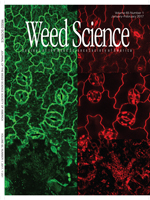Traditional breeding has been used to develop grain sorghum germplasm that is tolerant to acetolactate synthase (ALS)-inhibiting herbicides (Inzen Technology, DuPont). Inzen sorghum carries a double mutation in the ALS gene (Val560Ile and Trp574Leu), which confers high level of tolerance to ALS-inhibiting herbicides. Overreliance on ALS-inhibiting herbicides for weed control during the 1990s resulted in the evolution of ALS inhibitor—resistant shattercane populations in Nebraska. According to a survey conducted in 2013, ALS inhibitor—resistant weedy Sorghum populations persist in Nebraska. The objectives of this research were to determine whether the ALS mutations present in Inzen sorghum were present in the ALS inhibitor—resistant shattercane and johnsongrass populations detected in Nebraska and northern Kansas, and whether these populations evolved ALS resistance independently. Primers specific to the Val560 and Trp574 region of the ALS gene were used to screen the populations with PCR. The Trp574Leu mutation was present in one ALS inhibitor—resistant johnsongrass population. The Val560Ile was detected in three ALS inhibitor—resistant shattercane, one susceptible shattercane, one ALS inhibitor—resistant johnsongrass, and one susceptible johnsongrass population. Moreover, Val560Ile was present in resistant and/or susceptible individuals within johnsongrass and shattercane populations that were segregating for ALS resistance, indicating that by itself the Val560Ile mutation does not confer resistance to ALS-inhibiting herbicides. None of the populations presented both mutations simultaneously, as does Inzen sorghum. A shattercane population containing the Ser653Thr mutation was also detected. This research indicates that the ALS mutations present in Inzen sorghum already exist individually in weedy sorghum populations. Moreover, our results present strong evidence that ALS resistance in these populations evolved independently. Thus, widespread overreliance on ALS-inhibiting herbicides prior to adoption of glyphosate-tolerant crops in the 1990s exerted sufficient selective pressure on shattercane and johnsongrass populations for resistance to evolve multiple times in the Midwest. Finally, a survey of the 5′ portion of the ALS gene in more diverse wild and weedy Sorghum species was hampered by limited coverage in genomic resequencing surveys, suggesting that refined PCR-based methods will be needed to assess SNP variation in this gene region, which includes the Ala122, Pro197, and Ala205 codons known to confer ALS resistance in other species.
Nomenclature: Acetolactate synthase (ALS) -inhibiting herbicides, johnsongrass, Sorghum halepense (L.) Pers. SORHA, shattercane, Sorghum bicolor (L.) Moench ssp. drummondii (Nees ex Steud.) de Wet ex Davidse SORVLJ, sorghum, Sorfhum bicolor (L.) Moench ssp. Bicolor SORVU





